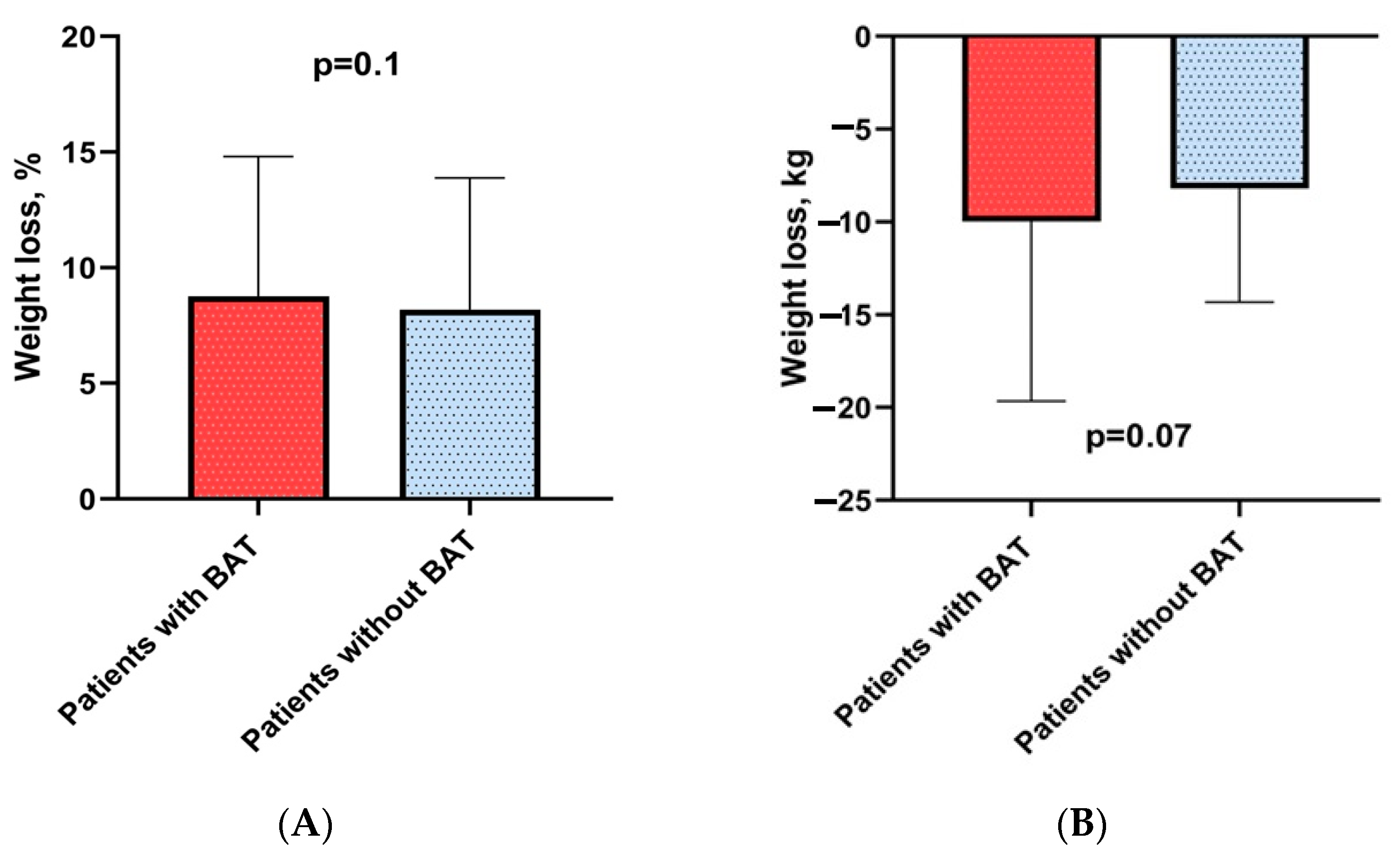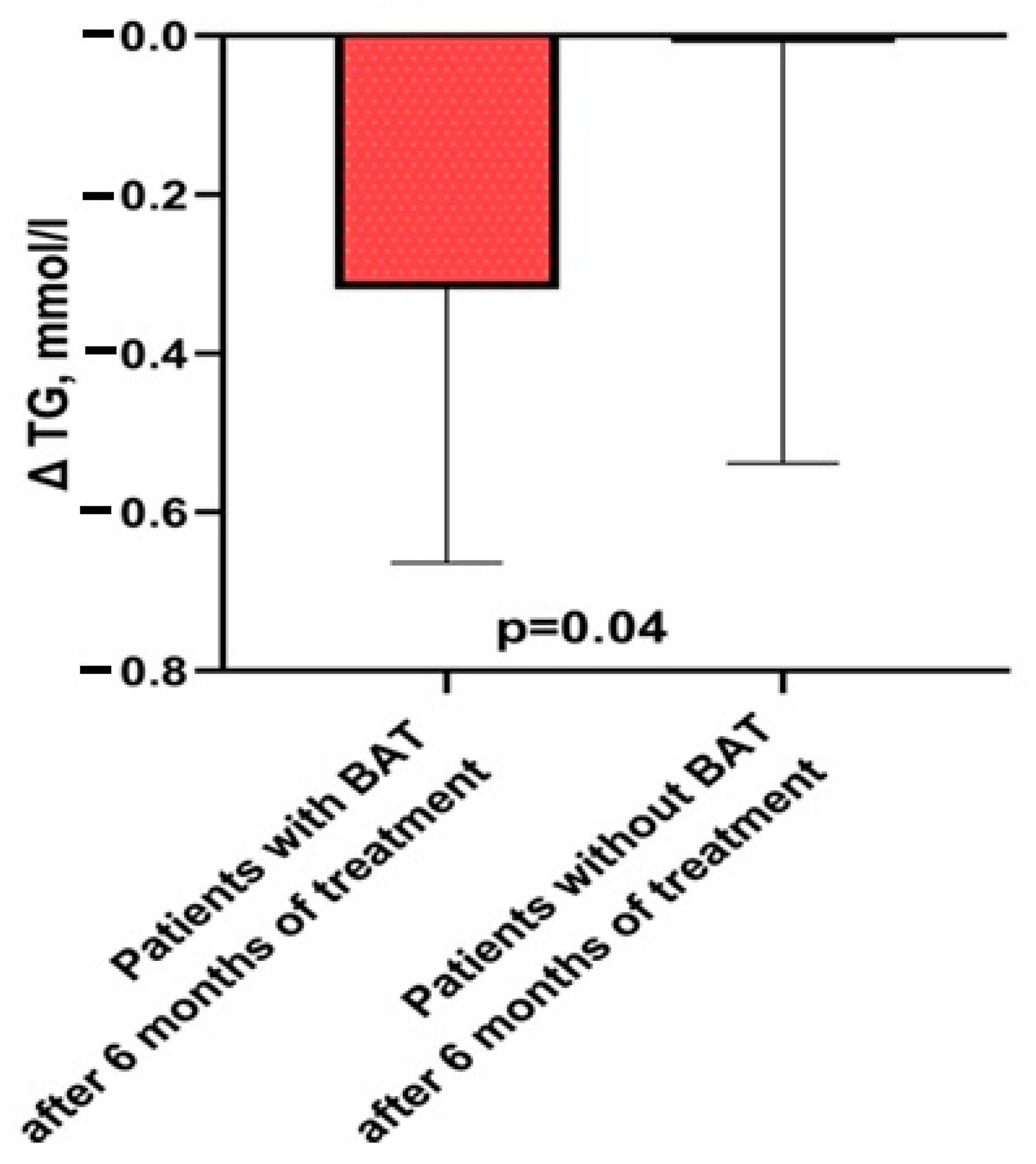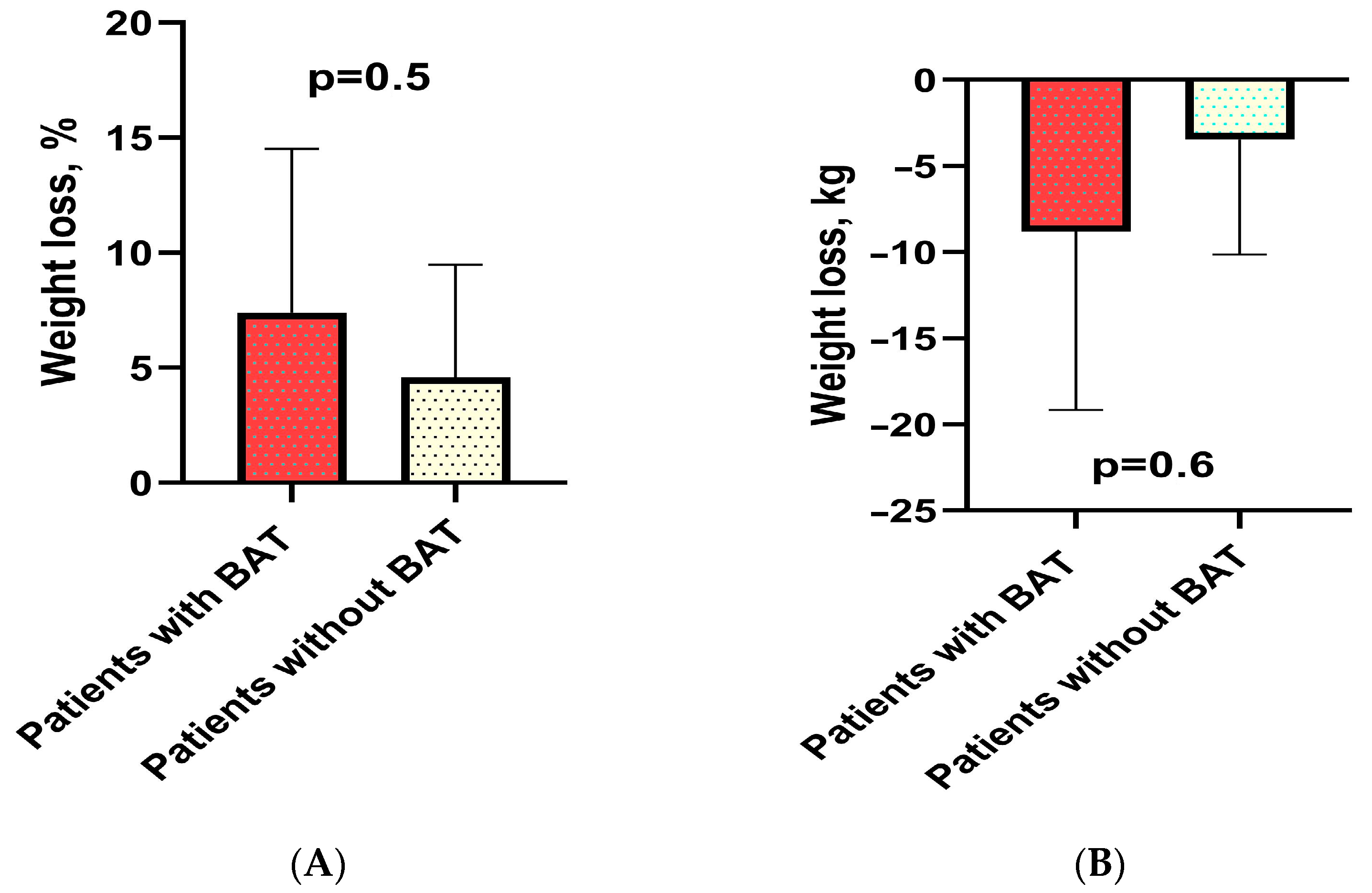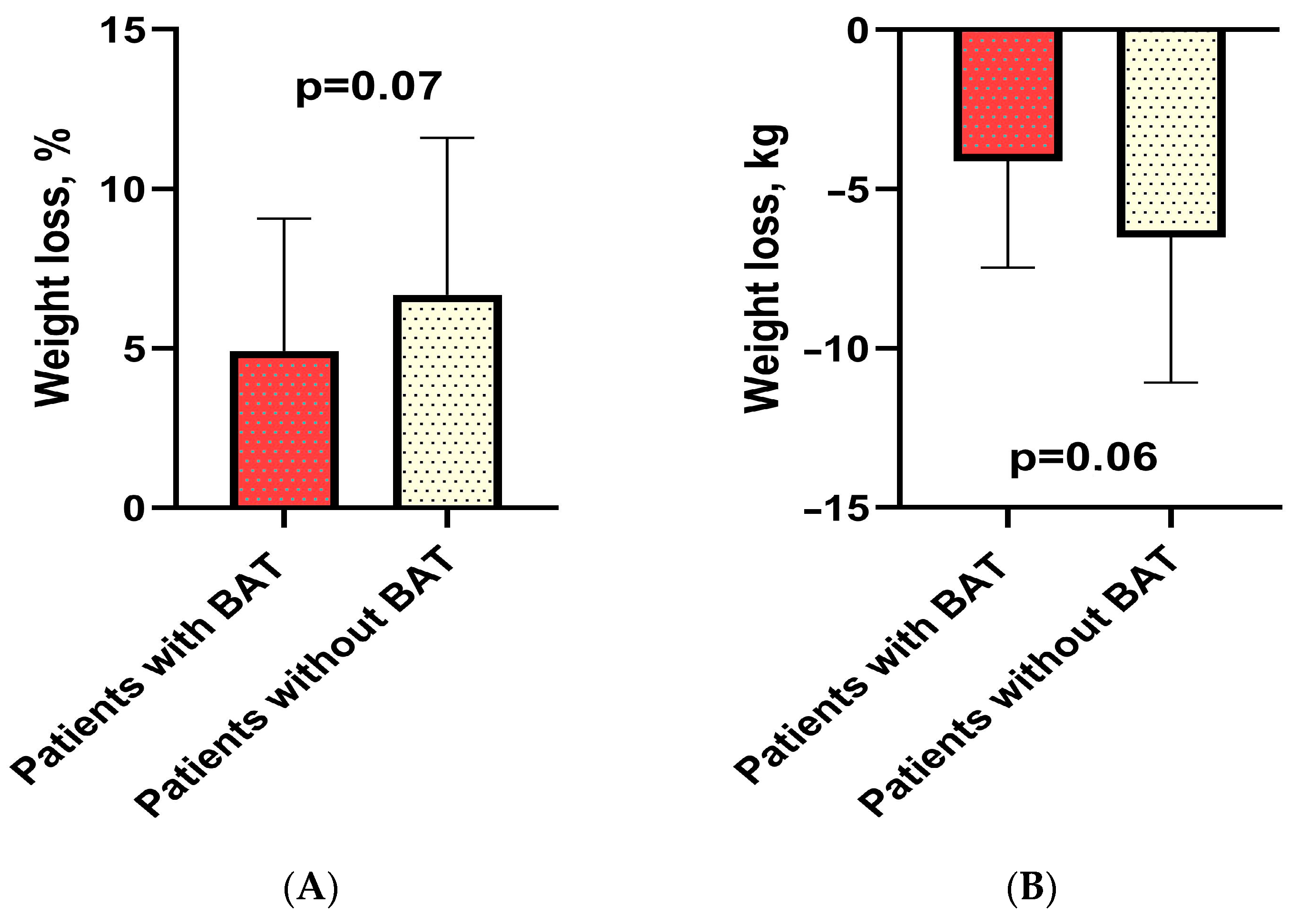Role of Brown Adipose Tissue in Metabolic Health and Efficacy of Drug Treatment for Obesity
Abstract
1. Introduction
2. Materials and Methods
2.1. Clinical Characteristics of the Examined Patients
2.2. Laboratory Methods
2.3. Instrumental Methods
2.4. Statistical Analysis
3. Results
3.1. Participants Characteristics
3.2. The Effect of BAT Presence on Weight Loss Efficiency and Metabolic Parameters
3.3. Dynamics of Weight Loss and Metabolic Parameters of Patients with BAT versus without BAT Undergoing Different Types of Therapy
3.4. Dynamics of Body Composition Parameters according to the Results of Densitometry
3.5. Changes in BAT during Therapy with Weight-Reducing Drugs
3.6. The Correlation between the Method of Weight-Reducing Therapy and Body Composition Parameters According to Densitometry
4. Discussion
5. Limitations of the Study
Author Contributions
Funding
Institutional Review Board Statement
Informed Consent Statement
Data Availability Statement
Conflicts of Interest
References
- Lee, M.-J.; Wu, Y.; Fried, S.K. Adipose Tissue Heterogeneity: Implication of depot differences in adipose tissue for Obesity Complications. Mol. Asp. Med. 2013, 34, 1–11. [Google Scholar] [CrossRef] [PubMed]
- Wu, J.; Boström, P.; Sparks, L.M.; Ye, L.; Choi, J.H.; Giang, A.-H.; Khandekar, M.; Virtanen, K.A.; Nuutila, P.; Schaart, G.; et al. Beige adipocytes are a distinct type of thermogenic fat cell in mouse and human. Cell 2012, 150, 366–376. [Google Scholar] [CrossRef]
- Atit, R.; Sgaier, S.K.; Mohamed, O.A.; Taketo, M.M.; Dufort, D.; Joyner, A.L.; Niswander, L.; Conlon, R.A. Beta-catenin activation is necessary and sufficient to specify the dorsal dermal fate in the mouse. Dev. Biol. 2006, 296, 164–176. [Google Scholar] [CrossRef] [PubMed]
- Timmons, J.A.; Wennmalm, K.; Larsson, O.; Walden, T.B.; Lassmann, T.; Petrovic, N.; Hamilton, D.L.; Gimeno, R.E.; Wahlestedt, C.; Baar, K.; et al. Myogenic gene expression signature establishes that brown and white adipocytes originate from distinct cell lineages. Proc. Natl. Acad. Sci. USA 2007, 104, 4401–4406. [Google Scholar] [CrossRef] [PubMed]
- Scheele, C.; Wolfrum, C. Brown Adipose Crosstalk in Tissue Plasticity and Human Metabolism. Endocr. Rev. 2020, 41, 53–65. [Google Scholar] [CrossRef] [PubMed]
- Yang, F.T.; Stanford, K.I. Batokines: Mediators of Inter-Tissue Communication (a Mini-Review). Curr. Obes. Rep. 2022, 11, 1–9. [Google Scholar] [CrossRef] [PubMed]
- Saito, M.; Okamatsu-Ogura, Y.; Matsushita, M.; Watanabe, K.; Yoneshiro, T.; Nio-Kobayashi, J.; Iwanaga, T.; Miyagawa, M.; Kameya, T.; Nakada, K.; et al. High incidence of metabolically active brown adipose tissue in healthy adult humans: Effects of cold exposure and adiposity. Diabetes 2009, 58, 1526–1531. [Google Scholar] [CrossRef] [PubMed]
- Hany, T.F.; Gharehpapagh, E.; Kamel, E.M.; Buck, A.; Himms-Hagen, J.; von Schulthess, G.K. Brown adipose tissue: A factor to consider in symmetrical tracer uptake in the neck and upper chest region. Eur. J. Nucl. Med. Mol. Imaging 2002, 29, 1393–1398. [Google Scholar] [CrossRef]
- Cohad, C.; Osman, M.; Pannu, H.K.; Wahl, R.L. Uptake in supraclavicular area fat (“USA-Fat”): Description on 18F–FDG-PET/CT. J. Nucl. Med. 2003, 44, 170–176. [Google Scholar]
- Cypess, A.M.; Lehman, S.; Williams, G.; Tal, I.; Rodman, D.; Goldfine, A.B.; Kuo, F.C.; Palmer, E.L.; Tseng, Y.H.; Doria, A.; et al. Identification and importance of brown adipose tissue in adult humans. N. Engl. J. Med. 2009, 360, 1509–1517. [Google Scholar] [CrossRef]
- Virtanen, K.A.; Lidell, M.E.; Orava, J.; Heglind, M.; Westergren, R.; Niemi, T.; Taittonen, M.; Laine, J.; Savisto, N.J.; Enerbäck, S.; et al. Functional brown adipose tissue in healthy adults. N. Engl. J. Med. 2009, 360, 1518–1525. [Google Scholar] [CrossRef] [PubMed]
- van der Lans, A.A.; Hoeks, J.; Brans, B.; Vijgen, G.H.; Visser, M.G.; Vosselman, M.J.; Hansen, J.; Jörgensen, J.A.; Wu, J.; Mottaghy, F.M.; et al. Cold acclimation recruits human brown fat and increases nonshivering thermogenesis. J. Clin. Investig. 2013, 123, 3395–3403. [Google Scholar] [CrossRef] [PubMed]
- Lin, K.; Dong, C.; Zhao, B.; Zhou, B.; Yang, L. Glucagon-like peptide-1 receptor agonist regulates fat browning by altering the gut microbiota and ceramide metabolism. MedComm 2023, 4, e416. [Google Scholar] [CrossRef]
- Janssen, L.G.M.; Nahon, K.J.; Bracké, K.F.M.; van den Broek, D.; Smit, R.; Mishre, A.S.D.S.; Koorneef, L.L.; Martinez-Tellez, B.; Burakiewicz, J.; Kan, H.E.; et al. Twelve weeks of exenatide treatment increases [18F]fluorodeoxyglucose uptake by brown adipose tissue without affecting oxidative resting energy expenditure in nondiabetic males. Metabolism 2020, 106, 154167. [Google Scholar] [CrossRef]
- Nedergaard, J.; Bengtsson, T.; Cannon, B. Unexpected evidence for active brown adipose tissue in adult humans. Am. J. Physiol. Endocrinol. Metab. 2007, 293, E444–E452. [Google Scholar] [CrossRef]
- World Health Organization. Body Mass Index. Available online: https://www.who.int/data/gho/data/themes/topics/topic-details/GHO/body-mass-index (accessed on 1 January 2004).
- Mirbolooki, M.R.; Constantinescu, C.C.; Pan, M.-L.; Mukherjee, J. Quantitative assessment of brown adipose tissue metabolic activity and volume using 18F-FDG PET/CT and β3-adrenergic receptor activation. EJNMMI Res. 2011, 1, 30. [Google Scholar] [CrossRef] [PubMed]
- Blondin, D.P.; Labbe, S.M.; Turcotte, E.E.; Haman, F.; Richard, D.; Carpentier, A.C. A critical appraisal of brown adipose tissue metabolism in humans. Clin. Lipidol. Metab. Disord. 2015, 10, 259–280. [Google Scholar] [CrossRef]
- van Marken Lichtenbelt, W.D.; Vanhommerig, J.W.; Smulders, N.M.; Drossaerts, J.M.; Kemerink, G.J.; Bouvy, N.D.; Schrauwen, P.; Teule, G.J. Cold-activated brown adipose tissue in healthy men. N. Engl. J. Med. 2009, 360, 1500–1508. [Google Scholar] [CrossRef]
- da Nadyellem Silva, G.; Amato, A.A. Thermogenic adipose tissue aging: Mechanisms and implications. Front. Cell Dev. Biol. 2022, 10, 955612. [Google Scholar]
- Rogers, N.H. Brown adipose tissue during puberty and with aging. Ann. Med. 2015, 47, 142–149. [Google Scholar] [CrossRef]
- Berry, D.C.; Jiang, Y.; Arpke, R.W.; Close, E.L.; Uchida, A.; Reading, D.; Berglund, E.D.; Kyba, M.; Graff, J.M. Cellular aging contributes to failure of cold-induced beige adipocyte formation in old mice and humans. Cell Metab. 2017, 25, 166–181. [Google Scholar] [CrossRef]
- Gonçalves, L.F.; Machado, T.Q.; Castro-Pinheiro, C.; de Souza, N.G.; Oliveira, K.J.; Fernandes-Santos, C. Ageing is associated with Brown adipose tissue remodelling and loss of white fat browning in female C57BL/6 mice. Int. J. Exp. Pathol. 2017, 98, 100–108. [Google Scholar] [CrossRef]
- McDonald, R.B.; Horwitz, B.A.; Hamilton, J.S.; Stern, J.S. Cold- and norepinephrine-induced thermogenesis in younger and older Fischer 344 rats. Am. J. Physiol. 1988, 254, 457–462. [Google Scholar] [CrossRef]
- Florez-Duquet, M.; McDonald, R.B. Cold-induced thermoregulation and biological aging. Physiol. Rev. 1998, 78, 339–358. [Google Scholar] [CrossRef]
- Scarpace, P.J.; Matheny, M.; Borst, S.E. Thermogenesis and mitochondrial GDP binding with age in response to the novel agonist CGP-12177A. Am. J. Physiol. 1992, 262, 185–190. [Google Scholar] [CrossRef]
- McDonald, R.B.; Horwitz, B.A. Brown adipose tissue thermogenesis during aging and senescence. J. Bioenerg. Biomembr. 1999, 31, 507–516. [Google Scholar] [CrossRef]
- Collins, K.J. Effects of cold on old people. Br. J. Hosp. Med. 1987, 38, 506–508, 510–512, 514. [Google Scholar]
- Zhang, Q.; Ye, H.; Miao, Q.; Zhang, Z.; Wang, Y.; Zhu, X.; Zhang, S.; Zuo, C.; Zhang, Z.; Huang, Z.; et al. Differences in the metabolic status of healthy adults with and without active brown adipose tissue. Wien. Klin. Wochenschr. 2013, 125, 687–695. [Google Scholar] [CrossRef]
- van Beek, S.; Hashim, D.; Bengtsson, T.; Hoeks, J. Physiological and molecular mechanisms of cold-induced improvements in glucose homeostasis in humans beyond brown adipose tissue. Int. J. Obes. 2023, 47, 338–347. [Google Scholar] [CrossRef]
- Than, A.; Xu, S.; Li, R.; Leow, M.S.; Sun, L.; Chen, P. Angiotensin type 2 receptor activation promotes browning of white adipose tissue and brown adipogenesis. Signal Transduct. Target. Ther. 2017, 2, 17022. [Google Scholar] [CrossRef]
- Rachid, T.L.; Penna-de-Carvalho, A.; Bringhenti, I.; Aguila, M.B.; Mandarim-de-Lacerda, C.A.; Souza-Mello, V. Fenofibrate (PPARalpha agonist) induces beige cell formation in subcutaneous white adipose tissue from diet-induced male obese mice. Mol. Cell Endocrinol. 2015, 402, 86–94. [Google Scholar] [CrossRef] [PubMed]
- Becher, T.; Palanisamy, S.; Kramer, D.J.; Eljalby, M.; Marx, S.J.; Wibmer, A.G.; Butler, S.D.; Jiang, C.S.; Vaughan, R.; Schöder, H.; et al. Brown adipose tissue is associated with cardiometabolic health. Nat. Med. 2021, 27, 58–65. [Google Scholar] [CrossRef] [PubMed]
- Orava, J.; Nuutila, P.; Noponen, T.; Parkkola, R.; Viljanen, T.; Enerbäck, S.; Rissanen, A.; Pietiläinen, K.H.; Virtanen, K.A. Blunted metabolic responses to cold and insulin stimulation in brown adipose tissue of obese humans. Obesity 2013, 21, 2279–2287. [Google Scholar] [CrossRef]
- Vijgen, G.H.E.J.; Bouvy, N.D.; Teule, G.J.J.; Brans, B.; Hoeks, J.; Schrauwen, P.; van Marken Lichtenbelt, W.D. Increase in brown adipose tissue activity after weight loss in morbidly obese subjects. J. Clin. Endocrinol. Metab. 2012, 97, E1229–E1233. [Google Scholar] [CrossRef] [PubMed]
- Weyer, C.; Gautier, J.; Danforth, E., Jr. Development of beta 3-adrenoceptor agonists for the treatment of obesity and diabetes an update. Diabetes Metab. 1999, 25, 11–21. [Google Scholar]
- Yau, W.W.; Singha, B.K.; Lesmanaa, R.; Zhou, J.; Sinha, R.A.; Wong, K.A.; Wu, Y.; Bay, B.-H.; Sugii, S.; Sun, L.; et al. Thyroid hormone (T3) stimulates brown adipose tissue activation via mitochondrial biogenesis and MTOR-mediated mitophagy. Autophagy 2019, 15, 131–150. [Google Scholar] [CrossRef] [PubMed]
- Hollingsworth, D.R.; Amatruda, T.T.; Scheig, R. Quantitative and qualitative effects of L-triiodothyronine in massive obesity. Metabolism Clin. Exp. 1970, 19, 934–945. [Google Scholar] [CrossRef]
- Ziqubu, K.; Mazibuko-Mbeje, S.E.; Mthembu, S.X.H.; Mabhida, S.E.; Jack, B.U.; Nyambuya, T.M.; Nkambule, B.B.; Basson, A.K.; Tiano, L.; Dludla, P.V. Anti-Obesity Effects of Metformin: A Scoping Review Evaluating the Feasibility of Brown Adipose Tissue as a Therapeutic Target. Int. J. Mol.Sci. 2023, 24, 2227. [Google Scholar] [CrossRef]
- Tai, T.-A.C.; Jennermann, C.; Brown, K.K.; Oliver, B.B.; MacGinnitie, M.A.; Wilkison, W.O.; Brown, H.R.; Lehmann, J.M.; Kliewer, S.A.; Morris, D.C. Activation of the nuclear receptor peroxisome proliferator-activated receptor gamma promotes brown adipocyte differentiation. J. Biol. Chem. 1996, 271, 29909–29914. [Google Scholar] [CrossRef] [PubMed]
- Cypess, A.M.; Weiner, L.S.; Roberts-Toler, C.; Elía, E.F.; Kessler, S.H.; Kahn, P.A.; English, J.; Chatman, K.; Trauger, S.A.; Doria, A.; et al. Activation of human brown adipose tissue by a beta3-adrenergic receptor agonist. Cell Metab. 2015, 21, 33–38. [Google Scholar] [CrossRef]
- O’Mara, A.E.; Johnson, J.W.; Linderman, J.D.; Brychta, R.J.; McGehee, S.; Fletcher, L.A.; Fink, Y.A.; Kapuria, D.; Cassimatis, T.M.; Kelsey, N.; et al. Chronic mirabegron treatment increases human brown fat, HDL cholesterol, and insulin sensitivity. J. Clin. Investig. 2020, 130, 2209–2219. [Google Scholar] [CrossRef] [PubMed]
- Bel, J.S. Mirabegron: The most promising adipose tissue beiging agent. Physiol. Rep. 2021, 9, e14779. [Google Scholar] [CrossRef] [PubMed]
- Oliveira, F.R.; Mamede, M.; Bizzi, M.F.; Rocha, A.L.L.; Ferreira, C.N.; Gomes, K.B.; Cândido, A.L.; Reis, F.M. Effects of Short Term Metformin Treatment on Brown Adipose Tissue Activity and Plasma Irisin Levels in Women with Polycystic Ovary Syndrome: A Randomized Controlled Trial. Horm. Metab. Res. 2020, 52, 718–723. [Google Scholar] [CrossRef]
- Srinivasa, S.; Wong, K.; Fitch, K.V.; Wei, J.; Petrow, E.; Cypess, A.M.; Torriani, M.; Grinspoon, S.K. Effects of lifestyle modification and metformin on irisin and FGF21 among HIV-infected subjects with the metabolic syndrome. Clin. Endocrinol. 2016, 82, 678–685. [Google Scholar] [CrossRef]
- Astrup, A.; Carraro, R.; Finer, N.; Harper, A.; Kunesova, M.; Lean, M.E.J.; Niskanen, L.; Rasmussen, M.F.; Rissanen, A.; Rössner, S.; et al. Safety, tolerability and sustained weight loss over 2 years with the once-daily human GLP-1 analog, liraglutide. Int. J. Obes. 2012, 36, 843–854. [Google Scholar] [CrossRef]
- Beiroa, D.; Imbernon, M.; Gallego, R.; Senra, A.; Herranz, D.; Villarroya, F.; Serrano, M.; Fernø, J.; Salvador, J.; Escalada, J.; et al. GLP-1 agonism stimulates brown adipose tissue thermogenesis and browning through hypothalamic AMPK. Diabetes 2014, 63, 3346–3358. [Google Scholar] [CrossRef] [PubMed]
- Vaittinen, M.; Ilha, M.; Herbers, E.; Wagner, A.; Virtanen, K.A.; Pietiläinen, K.H.; Pirinen, E.; Pihlajamäki, J. Liraglutide demonstrates a therapeutic effect on mitochondrial dysfunction in human SGBS adipocytes in vitro. Diabetes Res. Clin. Pract. 2023, 199, 110635. [Google Scholar] [CrossRef] [PubMed]
- Lynch, L.; O’Shea, D.; Winter, D.C.; Geoghegan, J.; Doherty, D.G.; O’Farrelly, C. Invariant NKT cells CD1d+ cells amass in human omentum are depleted in patients with cancer obesity. Eur. J. Immunol. 2009, 39, 1893–1901. [Google Scholar] [CrossRef]
- James, W.P.T.; Caterson, I.D.; Coutinho, W.; Finer, N.; Van Gaal, L.F.; Maggioni, A.P.; Torp-Pedersen, C.; Sharma, A.M.; Shepherd, G.M.; Rode, R.A.; et al. Effect of sibutramine on cardiovascular outcomes in overweight and obese subjects. N. Engl. J. Med. 2010, 363, 905–917. [Google Scholar] [CrossRef]
- Connoley, I.P.; Liu, Y.-L.; Frost, I.; Reckless, I.P.; Heal, D.J.; Stock, M.J. Thermogenic effects of sibutramine and its metabolites. Br. J. Pharmacol. 1999, 126, 1487–1495. [Google Scholar] [CrossRef]
- Giordano, A.; Centemeri, C.; Zingaretti, M.C.; Cinti, S. Sibutramine-dependent brown fat activation in rats: An immunohistochemical study. Int. J. Obes. 2002, 26, 354–360. [Google Scholar] [CrossRef] [PubMed][Green Version]
- Pan, D.; Mao, C.; Quattrochi, B.; Friedline, R.H.; Zhu, L.J.; Jung, D.Y.; Kim, J.K.; Lewis, B.; Wang, Y.-X. MicroRNA-378 controls classical brown fat expansion to counteract obesity. Nat. Commun. 2014, 5, 4725. [Google Scholar] [CrossRef] [PubMed]




| Characteristic | Patients with Obesity (n = 72) |
|---|---|
| Age, years | 37.8 ± 10.9 |
| % of males | 31.9 |
| % of smokers | 47.2 |
| Weight, kg | 105.5 ± 20.5 |
| BMI, kg/m2 | 35.9 ± 4.6 |
| Waist circumference, cm | 112.6 ± 14.2 |
| Hip circumference, cm | 120.01 ± 10.3 |
| Waist circumference/Hip circumference | 0.94 ± 0.11 |
| SBP, mm Hg | 124.8 ± 12.5 |
| DBP, mm Hg | 74.4 ± 9.1 |
| Glucose, mmol/L | 5.4 ± 0.6 |
| Insulin, mmol/L | 154.9 ± 100.5 |
| HOMA-IR | 5.3 ± 3.6 |
| HOMA-B | 275.7 ± 247.4 |
| HbA1c, % | 5.43 ± 0.26 |
| TC, mmol/L | 4.9 ± 1.05 |
| HDL-C, mmol/L | 1.17 ± 0.32 |
| LDL-C, mmol/L | 3.0 ± 0.9 |
| VLDL-C, mmol/L | 0.71 ± 0.45 |
| TG, mmol/L | 1.63 ± 1.03 |
| CRP, mg/L | 3.9 ± 3.6 |
| Characteristic | Patients with BAT, n = 14 | Patients without BAT, n = 58 | p-Value |
|---|---|---|---|
| Age, years | 30.8 ± 8.5 | 39.4 ± 10.8 | 0.006 |
| Weight, kg | 103.4 ± 24.9 | 105.96 ± 19.5 | 0.31 |
| BMI, kg/m2 | 35.4 ± 4.9 | 36.05 ± 4.5 | 0.63 |
| Waist circumference, cm | 105.0 ± 16.4 | 114.4 ± 13.1 | 0.02 |
| Hip circumference, cm | 117.4 ± 10.8 | 120.7 ± 10.1 | 0.67 |
| Waist circumference/Hip circumference | 0.9 ± 0.13 | 0.94 ± 0.1 | 0.09 |
| SBP, mm/Hg | 125.7 ± 11.6 | 124.6 ± 12.8 | 0.38 |
| DBP, mm/Hg | 73.7 ± 9.5 | 77.4 ± 7.2 | 0.16 |
| Glucose, mmol/L | 5.3 ± 0.45 | 5.4 ± 0.6 | 0.14 |
| Insulin, mmol/L | 130.6 ± 77.5 | 161.3 ± 106.0 | 0.39 |
| HOMA-IR | 4.3 ± 2.5 | 5.6 ± 3.8 | 0.3 |
| HOMA-B | 279.6 ± 302.8 | 274.7 ± 234.8 | 0.65 |
| HbA1c, % | 5.15 ± 0.45 | 5.42 ± 0.26 | 0.16 |
| TC, mmol/L | 4.42 ± 0.99 | 5.00 ± 1.05 | 0.07 |
| HDL-C, mmol/L | 1.17 ± 0.27 | 1.15 ± 0.23 | 0.44 |
| LDL-C, mmol/L | 2.62 ± 0.78 | 3.1 ± 0.9 | 0.052 |
| VLDL-C, mmol/L | 0.54 ± 0.2 | 0.77 ± 0.5 | 0.1 |
| TG, mmol/L | 1.30 ± 0.29 | 1.69 ± 0.77 | 0.03 |
| CRP, mg/L | 4.71 ± 3.7 | 3.78 ± 3.6 | 0.25 |
| Parameter | Patients with BAT before the Treatment | Patients with BAT after 6 Months of Treatment | p-Value | Patients without BAT before the Treatment | Patients without BAT after 6 Months of Treatment | p-Value |
|---|---|---|---|---|---|---|
| Waist circumference, cm | 105.0 ± 16.4 | 95.1 ± 11.2 | <0.01 | 114.4 ± 13.2 | 103.6 ± 13.1 | <0.001 |
| Hip circumference, cm | 117.3 ± 10.7 | 111.7 ± 10.9 | 0.02 | 120.6 ± 10.2 | 115.3 ± 12.6 | <0.001 |
| TG, mmol/L | 1.16 ± 0.36 | 0.85 ± 0.3 | 0.04 | 1.69 ± 1.03 | 1.65 ± 0.95 | 0.46 |
| Glucose, mmol/L | 5.67 ± 0.44 | 5.4 ± 0.49 | 0.07 | 5.28 ± 0.65 | 5.18 ± 0.69 | 0.309 |
| Characteristic | Reduxin (1) | Reduxin Forte (2) | Liraglutide (3) | Diet (4) | p 1 vs. 2 | p 1 vs. 3 | p 1 vs. 4 | p 2 vs. 3 | p 2 vs. 4 | p 3 vs. 4 |
|---|---|---|---|---|---|---|---|---|---|---|
| Age, years | 37.2 ± 8.4 | 35.8 ± 11.3 | 42.3 ± 13.2 | 35.8 ± 10.6 | 0.5 | 0.2 | 0.7 | 0.1 | 0.9 | 0.2 |
| Male/female (%) | 45/55 | 16/84 | 27/73 | 40/60 | 0.07 | 0.2 | 0.7 | 0.4 | 0.1 | 0.4 |
| Δ Weight, kg | −10.0 ± 5.83 | −6.89 ± 5.48 | −10.47 ± 4.84 | −3.45 ± 6.67 | 0.2 | 0.6 | 0.09 | 0.01 | 0.2 | 0.06 |
| Δ Weight, % | −9.56 ± 6.18 | −7.42 ± 5.89 | 9.85 ± 4.1 | 4.59 ± 4.87 | 0.4 | 0.5 | 0.09 | 0.5 | 0.2 | 0.07 |
| BMI, kg/m2 | 36.81 ± 4.4 | 34.89 ± 4.42 | 36.5 ± 4.75 | 35.3 ± 4.8 | 0.1 | 0.8 | 0.3 | 0.3 | 0.8 | 0.4 |
| Glucose, mmol/L | 5.18 ± 0.64 | 5.44 ± 0.46 | 5.46 ± 0.7 | 5.4 ± 0.6 | 0.1 | 0.1 | 0.1 | 0.9 | 0.8 | 0.9 |
| Insulin, mmol/L | 173.1 ± 108.8 | 143.9 ± 128.3 | 177.2 ± 86.8 | 119.2 ± 52.8 | 0.1 | 0.6 | 0.1 | 0.06 | 0.6 | 0.08 |
| HOMA-IR | 5.72 ± 3.69 | 5.1 ± 4.65 | 6.18 ± 3.09 | 4.13 ± 1.89 | 0.2 | 0.5 | 0.2 | 0.08 | 0.7 | 0.09 |
| TC, mmol/L | 4.88 ± 1.12 | 4.47 ± 0.98 | 5.28 ± 1.03 | 5.01 ± 0.95 | 0.2 | 0.3 | 0.5 | 0.04 | 0.1 | 0.3 |
| HDL-C, mmol/L | 1.08 ± 0.3 | 1.24 ± 0.27 | 1.22 ± 0.4 | 1.15 ± 0.3 | 0.08 | 0.3 | 0.4 | 0.6 | 0.2 | 0.7 |
| LDL-C, mmol/L | 2.97 ± 0.84 | 2.67 ± 0.84 | 3.42 ± 0.93 | 3.03 ± 0.94 | 0.2 | 0.1 | 0.9 | 0.03 | 0.2 | 0.1 |
| TG, mmol/L | 1.81 ± 1.18 | 1.2 ± 0.5 | 1.7 ± 0.97 | 1.79 ± 1.25 | 0.08 | 0.9 | 0.6 | 0.08 | 0.1 | 0.9 |
| CRP, mg/L | 3.75 ± 2.78 | 5.0 ± 5.1 | 3.37 ± 3.1 | 3.63 ± 3.29 | 0.7 | 0.6 | 0.7 | 0.36 | 0.5 | 0.8 |
| Reduxin | |||
| Characteristic | 0 months of therapy | 6 months of therapy | p-value |
| Total volume of BAT (cm3) | 6.19 ± 5.54 | 30.97 ± 33.96 | 0.08 |
| SUV max (g/mL) | 2.71 ± 2.52 | 3.74 ± 1.45 | 0.01 |
| SUV mean (g/mL) | 1.79 ± 1.57 | 1.98 ± 0.84 | 0.02 |
| Reduxin Forte | |||
| 0 months of therapy | 6 months of therapy | p-value | |
| Total volume of BAT (cm3) | 77.0 ± 123.1 | 128.0 ± 199.2 | 0.98 |
| SUV max (g/mL) | 1.77 ± 1.75 | 3.83 ± 3.91 | 0.78 |
| SUV mean (g/mL) | 0.97 ± 0.87 | 1.66 ± 1.28 | 0.82 |
| Liraglutide | |||
| Characteristic | 0 months of therapy | 6 months of therapy | p-value |
| Total volume of BAT (cm3) | 29.9 ± 43.7 | 147.2 ± 107.3 | 0.04 |
| SUV max (g/mL) | 2.78 ± 3.71 | 8.47 ± 4.46 | 0.02 |
| SUV mean (g/mL) | 198 ± 2.36 | 3.52 ± 1.64 | 0.02 |
| Lifestyle modification | |||
| Characteristic | 0 months of therapy | 6 months of therapy | p-value |
| Total volume of BAT (cm3) | 208.6 ± 239.8 | 404.5 ± 384.5 | 0.1 |
| SUV max (g/mL) | 9.9 ± 5.46 | 13.1 ± 4.1 | 0.6 |
| SUV mean (g/mL) | 3.46 ± 1.6 | 4.1 ± 1.2 | 0.6 |
Disclaimer/Publisher’s Note: The statements, opinions and data contained in all publications are solely those of the individual author(s) and contributor(s) and not of MDPI and/or the editor(s). MDPI and/or the editor(s) disclaim responsibility for any injury to people or property resulting from any ideas, methods, instructions or products referred to in the content. |
© 2024 by the authors. Licensee MDPI, Basel, Switzerland. This article is an open access article distributed under the terms and conditions of the Creative Commons Attribution (CC BY) license (https://creativecommons.org/licenses/by/4.0/).
Share and Cite
Markina, N.O.; Matveev, G.A.; Zasypkin, G.G.; Golikova, T.I.; Ryzhkova, D.V.; Kononova, Y.A.; Danilov, S.D.; Babenko, A.Y. Role of Brown Adipose Tissue in Metabolic Health and Efficacy of Drug Treatment for Obesity. J. Clin. Med. 2024, 13, 4151. https://doi.org/10.3390/jcm13144151
Markina NO, Matveev GA, Zasypkin GG, Golikova TI, Ryzhkova DV, Kononova YA, Danilov SD, Babenko AY. Role of Brown Adipose Tissue in Metabolic Health and Efficacy of Drug Treatment for Obesity. Journal of Clinical Medicine. 2024; 13(14):4151. https://doi.org/10.3390/jcm13144151
Chicago/Turabian StyleMarkina, Natalia O., Georgy A. Matveev, German G. Zasypkin, Tatiana I. Golikova, Daria V. Ryzhkova, Yulia A. Kononova, Sergey D. Danilov, and Alina Yu. Babenko. 2024. "Role of Brown Adipose Tissue in Metabolic Health and Efficacy of Drug Treatment for Obesity" Journal of Clinical Medicine 13, no. 14: 4151. https://doi.org/10.3390/jcm13144151
APA StyleMarkina, N. O., Matveev, G. A., Zasypkin, G. G., Golikova, T. I., Ryzhkova, D. V., Kononova, Y. A., Danilov, S. D., & Babenko, A. Y. (2024). Role of Brown Adipose Tissue in Metabolic Health and Efficacy of Drug Treatment for Obesity. Journal of Clinical Medicine, 13(14), 4151. https://doi.org/10.3390/jcm13144151







